This “project” is only going to have three entries this year, since the season of Stanley Tucci: Searching for Italy only has six episodes and I’m covering two in each post. Episodes 3 & 4, our man Stan travels to Emilia-Romagna and Lombardia, spending much of his time in the major cities of, respectively, Bologna and Milan. I like that he’s decided to hop around to states in different parts of the country rather than doing, say, all southern states first, and then another section, etc. It gives the overall season a more balanced feel.
Let’s face it, in Bologna the most likely thing he was going to have someone show him how to make is Bolognese sauce. Of course, in Bologna, they don’t call it that, usually, they just call it ragú, or meat sauce, because why would they need to name it for where they are? And in Bologna province (provinces in Italy are kind of like what we’d call counties in the US) with a population currently listed at 1,007,644 people, there are probably 1,007,643 recipes for ragú, because you know Giovanna down the block copied hers from your grandmother. Tucci first gets into a monologue about the use of tomatoes or not, milk/cream or not, long or short cooking times, and then finally pays attention to the woman who’s showing him her family recipe.
She’s a lovely older woman, with a huge house and garden. I didn’t quite get who she was or how he ended up talking to her about how to make the ragú, but it’s clear she’s got some definite IDEAS. I also think that I might have added one ingredient, I didn’t write down wine as I was scribbling notes during the show – I know they were drinking it, but maybe she didn’t add it and I’ve gone and adulterated her recipe. I will say that this is a far cry from the way I learned to make the sauce. But that’s kind of my point above.
We’ve got ground veal (not milk fed veal, we don’t have that here, and I don’t think they do in Italy either), sliced pieces of bacon, finely chopped onion, carrot, and celery, “stock”, which was not specified, and was probably chicken, but I went with beef, the wine in question, some flour with a big pinch of nutmeg, and some butter. Salt and pepper, of course.
This is a really quick version of Bolognese, as Tucci pointed out, he waited a whole ten minutes for lunch after the prep work. It’s maybe more like twenty, but it’s really fast. Put the butter, meats, and vegetables in a pot, and cook them over medium heat until the meat is browned. Add the flour/nutmeg and cook, stirring, for another minute.
Add the wine (or not, since I don’t think she did) and the stock and cook until you’ve got a thickened sauce (that’s what the flour is there for). It’s interesting, given the way she cut the vegetables, along with the flour, it just feels like a very French way of making a sauce rather than Italian. I know she talked about the recipe being long passed down in her family, but it’d be interesting to know if there is some kind of French cooking training back a few generations. Anyway, adjust the salt and pepper seasoning and done. That’s it. No tomato, no dairy, and a really quick cook.
Her pasta is, as she is proud to point out, the classic tagliatelle of the region – ragú is just not paired with spaghetti, it’s too thin to be appropriate for the sauce. While there are, at least in modern day, Italians who pair meat sauce with spaghetti over there, it’s really more of a British and American dish, because traditionally Italians would pair this sauce with a wider pasta. Spaghetti tends to get thinner sauces, like a tomato sauce, or vegetable sauce, or, something like the dish I demoed in the last post, with zucchini butter. Here we’ve got a lower gluten, all-purpose flour, a big pinch of salt, and one whole egg plus an extra yolk. I actually ended up adding in another yolk as it wasn’t quite enough.
Mix the dough together and knead it until smooth. Let it rest for 20-30 minutes to relax what gluten you have developed. Roll it out into a thin sheet, dust it with flour, roll it up in a log, and slice your tagliatelle, roughly 1cm in width. Boil in salted water for about 3 minutes until al dente.
Now, I would normally have thickened the sauce at the last minute by using the starchy pasta water and tossing with the sauce, but she didn’t, since she’d already thickened it with flour in the mix. And she spooned the sauce over the top of the pasta. So, just for the photo, that’s what I did too, along with a little grated parmesan. Then I mixed it all together.
So, it’s a perfectly good sauce, but honestly, it has no complexity to it, it’s missing the richness and acidity that tomato paste and a little bit of crushed tomato could give it, and that slight creaminess that milk adds, it has no herbs, no real seasoning, it’s kind of 1960s home economics class pasta sauce. If you’re in a hurry and you want ragú then yeah, it’ll work, but I don’t see me making it again. It was actually better the next day tossed with a bowl of leftover rice and just heated up in the microwave.
The classic red wine of Emilia-Romagna is Lambrusco. We’re not talking the sweet fizzy stuff that has a huge grip on the American market, but the real stuff, which is a dry red wine made from the grape of the same name. Here in Argentina there are maybe three producers of it that I’ve heard of, and the Don Bosco Lambrusco Reserva 2017 was an easy get for me as they’re associated with the local Don Bosco convent, which has a gift shop where they sell the wine. Light to medium bodied with fairly high acidity, slightly green tannins, very fruit forward with flavors of black cherry, watermelon, a hint of black olive, and a medium length finish. Good, perfectly drinkable wine, no wows, but then, it’s a whopping 320 pesos, or about $3.50.
Next we’re off to Lombardia, or Lombardy in English, and the home of risotto, so it’s no surprise that that’s the direction he took when looking for someone to show him a recipe. Interestingly, not the classic risotto milanese, which is a beautiful golden saffron infused one, which, while he did sample, the chef who he was talking to didn’t give any details to his preparation method. While I know how to make one, I wanted to go with the recipe that actually got demonstrated, which was by a local fisherman up on Lake Como, and a classic local dish, riso con persico, or rice with perch, which they spent some time catching in the lake.
First off, I wasn’t going to find lake perch here. There are some down in Patagonia, but they don’t make it to the fishmongers in Buenos Aires. I could have gone with an ocean fish that’s similar, something like a bass or porgy, but I wanted to go with something light and delicate, and freshwater, to be as close as I could to the original, and I decided to go with pejerrey, or silverside, a fish that looks a little bit like a white, translucent trout, and fit the bill. Carnaroli rice for the risotto, a finely chopped shallot, some fish stock, white wine, butter, and some fresh sage leaves, along with salt and pepper.
In a splash of olive oil, sauté the shallot over low heat for about a minute, then add the rice and stir to coat and toast for about two minutes.
I’m not going to show every step in photos, but first, pour in the wine, and cook, stirring regularly, until the wine is absorbed. Then begin adding the stock (preheated please!), one ladleful at a time, each time cooking until the liquid is absorbed, stirring or shaking the pan regularly. It will take about twenty minutes to do this right, and roughly three times the volume of liquid as the volume of rice.
The rice should have a creamy, but still slightly al dente texture, you should have the sense that you can still chew it, without it being hard. Mix in the butter, adjust the seasoning if need be (depends on your fish stock and how well seasoned it is). And, it’s ready to go.
When your rice is almost done, or really, because this goes so fast, when it is done, it’s time to cook the fish. A splash of olive oil over medium heat, lightly salt the fish on both sides, and cook the fish and the sage leaves until the fish is cooked through. With fillets this thin and delicate, it literally took about a minute on each side and they were done.
Serve the fish and sage leaves over the risotto. Again, this is a very simple, home cooking kind of dish. It’s tasty, and I’d happily eat it again, but it’s not some amazing find. Then again, if I look at the recipes he’s focusing on getting the details of, that’s kind of what they are, even if somewhat unusual in the first round of two, neither of those was difficult to make. Maybe that’s his intent, to offer up something that a good home cook can whip up for dinner and enjoy.
Lombardia has a bunch of really good wines, both white and red. Probably the most famous of the white end is a sparkling, Franciacorta, which is a blend of Chardonnay and Pinot Bianco. The latter isn’t a common grape here in Argentina, and I was actually surprised to find a Chardonnay and Pinot Bianco blend sparkling, the Bodega Putruele Extra Brut Non-Vintage from the San Martín appellation of San José province. I used the wine in the risotto as well as to drink with it, and it was delicious. Easily as good as many of the Franciacortas that I’ve had over the years – with good acidity, and flavors of green apple, raspberry, and a bit of coconut oakiness. 481 pesos ($5) at, of all places, the supermarket.
And, that’s round 2!
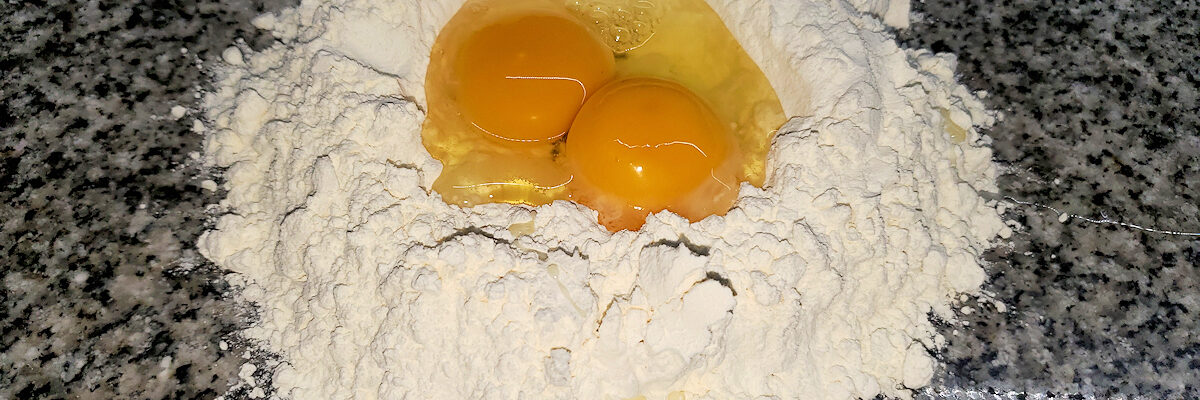
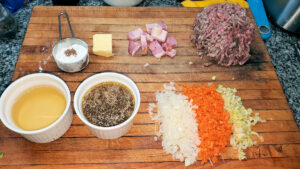
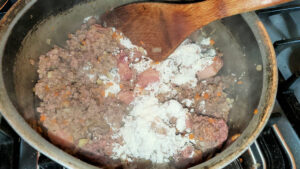
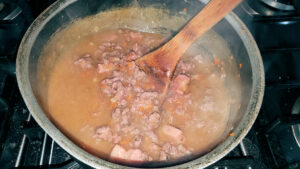
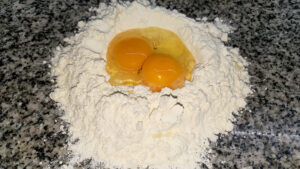
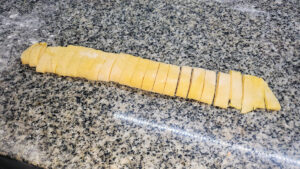
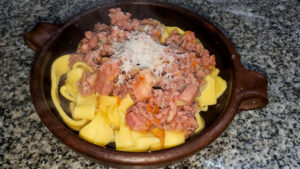
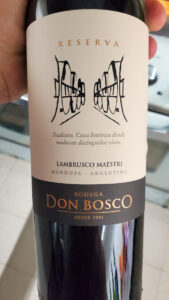
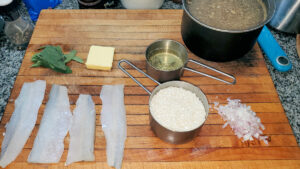
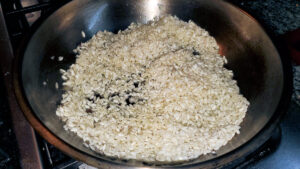
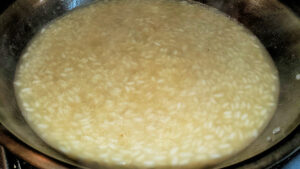
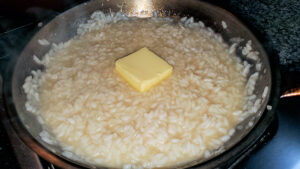
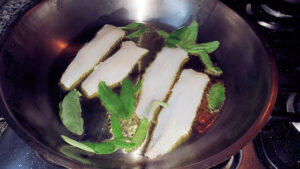
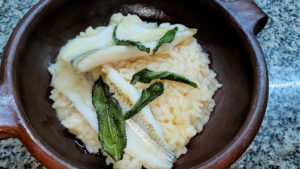
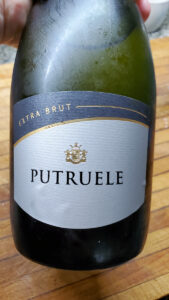
I think you’re spot on with this comment: “that’s his intent, to offer up something that a good home cook can whip up for dinner and enjoy.” That’s also how you get a second season on CNN.
[…] tromping about in Italy. In the fifth and sixth episodes he heads to Tuscany and Sicily. All past comments on the show could be repeated here, so I won’t. Let’s go straight to the […]